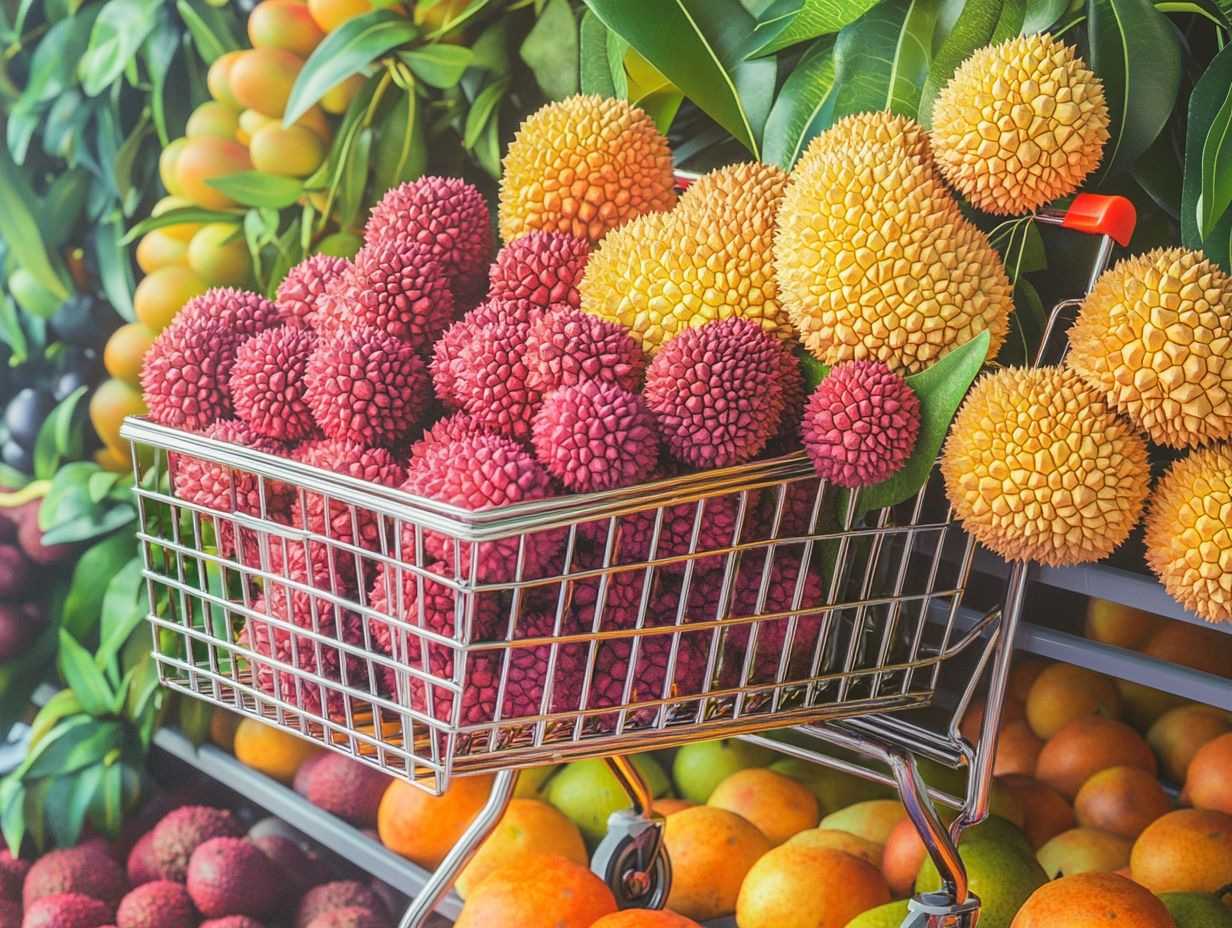I invite you to explore the delightful world of lychee berry labubu, a unique treat that offers both exceptional flavor and numerous health benefits. I aim to provide guidance on how to purchase the **labubu series**, including where to find it and what factors to consider before making a purchase. Additionally, I will highlight the various flavors and varieties available, along with **creative ways** to incorporate them into your meals. It is important to address potential **side effects** and **precautions** to keep in mind. Join me on this flavorful journey!
What is labubu and its Benefits?

Labubu, commonly known as lychee berry, is an exotic tropical fruit celebrated for its sweet and succulent taste, making it one of the most popular lychee fruit varieties. This intriguing fruit hails from various regions in Asia, particularly China and Southeast Asia, including countries such as Thailand, Vietnam, and Malaysia.
With its distinctive flavor profile and appealing texture, labubu is not only a delightful addition to desserts and smoothies but also offers numerous health benefits, enhancing its reputation in the tropical fruit market. It is rich in vitamins, minerals, and antioxidants, making it an excellent choice for enhancing overall wellness, particularly for health-conscious consumers.
Incorporating labubu into a healthy diet can be highly advantageous due to its low calorie and high fiber content, which supports digestion and aids in weight management, further underlining its nutritional value. This superfruit serves as an excellent source of vitamin C, vital for immune function and skin health. Additionally, its antioxidant properties combat free radicals, promoting cellular health and reducing inflammation.
Sustainable farming methods, particularly organic farming, help preserve the natural quality of labubu, ensuring that health-conscious consumers can enjoy it without any guilt, thanks to organic fruits practices. The seasonal availability of labubu typically peaks in summer, offering an opportunity for fresh, flavorful consumption. It can also be sourced from local markets that prioritize high-quality produce.
How to Buy lychee berry labubu Series
When purchasing the lychee berry labubu series, I find that understanding the best practices for buying this tropical fruit significantly enhances my shopping experience, including lychee sourcing strategies.
Whether I am a first-time buyer or a seasoned fruit enthusiast, it is essential to navigate local markets and online shopping platforms effectively, exploring various fruit suppliers and vendors. This involves being aware of seasonal availability, comparing prices, and selecting reliable suppliers who offer freshness guarantees and efficient delivery options.
Where to Purchase

Finding the best places to purchase labubu, or lychee berry, significantly impacts the quality and freshness of this exotic fruit. Whether I am sourcing labubu from local markets, wholesale suppliers, or online shopping platforms, knowing where to look allows me to secure the best options available.
Each purchasing avenue presents unique advantages, making it essential to consider factors such as vendor reputation and product freshness.
Local markets typically showcase seasonal produce at competitive prices, giving me the opportunity to inspect the fruit before purchase and ensure optimal ripeness, offering insights into lychee preservation tips. Conversely, reputable suppliers can offer bulk purchasing options, which may lead to substantial savings if I require a larger quantity.
For those who prioritize convenience, reliable online vendors provide a hassle-free experience, delivering fresh labubu directly to my doorstep through efficient fruit delivery services.
Each avenue has its own strengths, and by carefully evaluating them, I can find the perfect balance between quality, cost, and convenience in obtaining my desired fruit.
Factors to Consider Before Buying
Before I make a purchase decision for labubu, I consider several essential factors that can significantly impact my satisfaction with the fruit. Understanding the indicators of ripeness, ensuring quality assurance, and comparing prices across different vendors are crucial steps in my buying process. Additionally, being mindful of seasonal availability enhances my chances of obtaining the freshest and most flavorful labubu.
When assessing ripeness, I look for a vibrant color and a slight give upon gentle pressure, which indicates optimal sweetness and flavor. The quality of the vendor is also paramount; reputable sellers typically prioritize freshness and handle their produce with care, ensuring the nutritional value is preserved.
Price comparisons are equally important to me; a higher price does not always equate to better quality, so exploring various options allows me to find the best deal without compromising quality.
I find that local markets often provide valuable insights into seasonal varieties, making them an excellent resource for sourcing the best labubu at the right time.
Different Types of lychee berry labubu Series

The lychee berry labubu series includes a range of varieties, each presenting unique flavors and textures that appeal to a wide array of culinary preferences, showcasing diverse lychee flavor profiles.
I appreciate the sweet and juicy qualities of certain labubu varieties, as well as the more exotic and lesser-known options.
By understanding these differences, I can enhance my overall experience with this tropical fruit.
Whether I’m incorporating labubu into desserts, juices, or snacks, exploring the various types allows me to find the perfect match for my taste and cooking requirements.
Comparing Different Flavors and Varieties
When I compare the flavors and varieties of labubu, I find that each type offers a unique taste and texture that enhances culinary experiences.
For instance, some labubu varieties have a rich, creamy texture that pairs beautifully with savory dishes like grilled chicken or fish, providing an intriguing contrast. Others exhibit a brighter acidity, making them ideal for balancing sweet desserts or enhancing the vibrant notes in a fruit salsa.
Their versatility is also evident in beverages; I can blend labubu to create enticing smoothies, combining it with fruits such as mango or pineapple to amplify their natural flavors. By experimenting with these different types of labubu, I can unlock a world of culinary possibilities, creating recipes that are both delicious and visually appealing.
How to Use lychee berry labubu Series

Incorporating the lychee berry labubu series into my diet provides an excellent opportunity to enjoy this tropical fruit while expanding my culinary repertoire.
From refreshing smoothies to vibrant desserts, labubu’s sweet and juicy characteristics make it a versatile ingredient that can enhance a variety of dishes.
By exploring different culinary applications and innovative recipes, I can fully appreciate the unique qualities of labubu.
Lychee Recipes and Tips for Incorporating into Your Diet
To maximize my labubu experience, I find that incorporating it into my diet through various lychee recipes is both enjoyable and rewarding. Whether I am crafting delicious smoothies infused with tropical flavors or creating exquisite desserts, the possibilities for using lychee berry in my meals are endless. These recipes not only highlight the unique taste of labubu but also demonstrate its versatility in complementing different culinary styles.
For example, I often blend labubu with yogurt, honey, and a hint of vanilla to create a refreshing smoothie that can effectively kickstart my day. Alternatively, I enjoy using labubu in salads, pairing it with mixed greens, avocado, and a citrus vinaigrette for a burst of flavor and nutrition.
When I’m in the mood for something sweet, a labubu-infused panna cotta serves as an elegant dessert option. Additionally, using labubu as a topping for pancakes elevates the breakfast experience with its juicy sweetness. The adaptability of this fruit allows me to harmonize it with various ingredients, making it an excellent choice for experimentation in the kitchen.
Potential Side Effects of lychee berry labubu Series
While I appreciate the numerous health benefits of labubu, or lychee berry, it is equally important to remain aware of potential side effects that may arise from its consumption, including lychee allergies.
Understanding possible reactions and implementing appropriate precautions can help ensure a safe and enjoyable experience with this tropical fruit.
By staying informed, I can enjoy labubu while minimizing any health risks associated with its consumption.
Possible Reactions and Precautions
When enjoying labubu, it is essential to be cognizant of potential reactions that certain individuals may experience, particularly those with specific dietary preferences or allergies, ensuring safe lychee consumption. Taking precautions, such as moderating consumption and understanding individual sensitivities, can help ensure that I enjoy the health benefits of this exotic fruit without encountering adverse effects.
Considering these factors is vital for a safe and pleasant eating experience.
Individuals who have allergies to other fruits, especially those in the related stone fruit family, may experience cross-reactivity, leading to oral allergy syndrome or gastrointestinal discomfort. For those with sensitivities, I find that staggering consumption or gradually introducing labubu into their diet can help identify any adverse reactions.
It is also prudent to wash the fruit thoroughly to reduce any pesticide residue or contaminants that could pose health risks.
Furthermore, educating myself about proper storage methods and preparation techniques can enhance food safety and allow me to fully appreciate the unique flavors of labubu while safeguarding my health.

